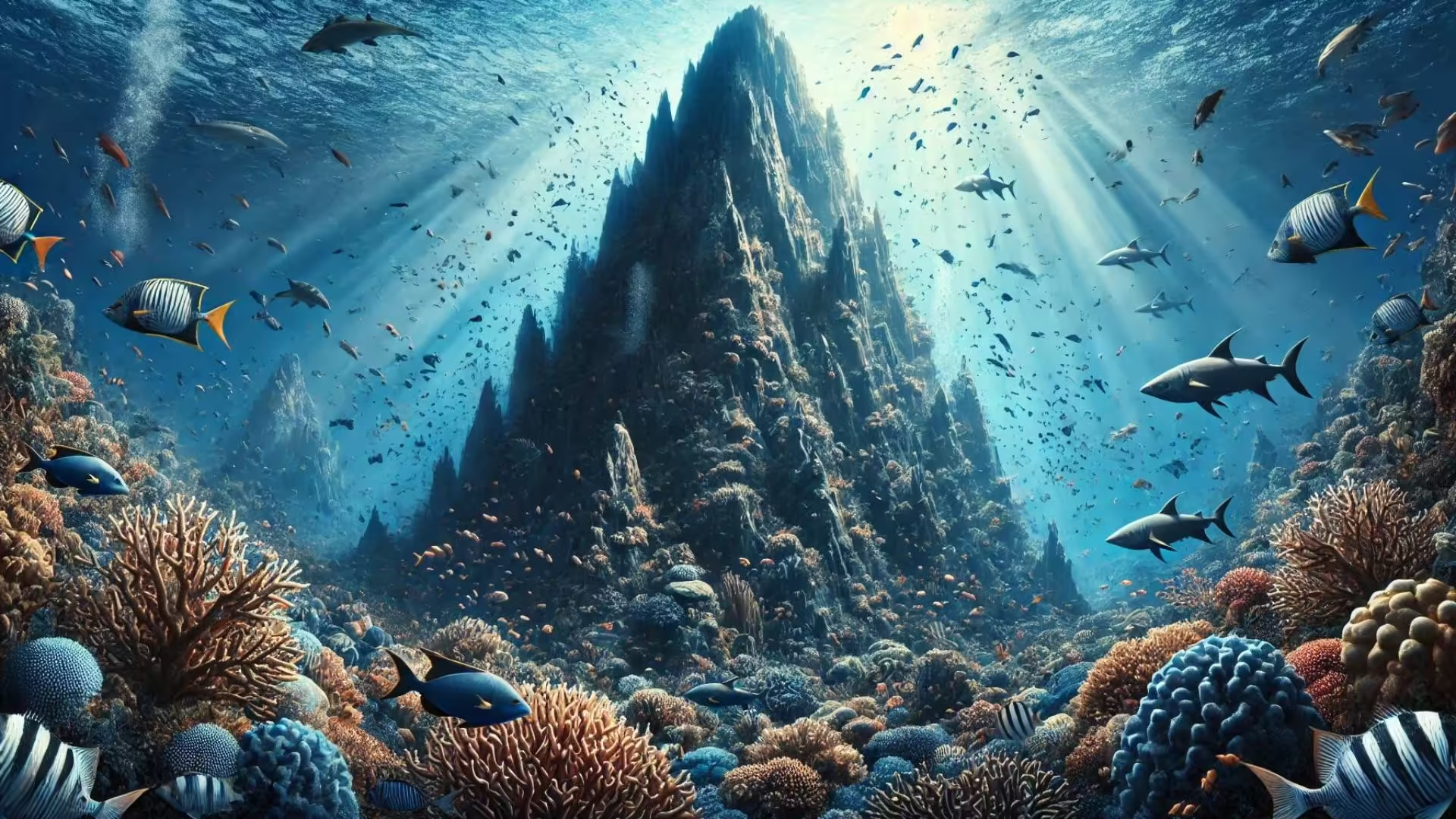- Seamounts: Underwater Giants Shaping Our Oceans
- What Are Seamounts?
- The Role of Seamounts in Marine Ecosystems
- Seamounts and Ocean Circulation
- The Hidden Importance of Seamounts
- Threats to Seamounts
- Applying This Knowledge in Real Life
- Call to Action: Protect the Underwater Giants
- Expand Your Vocabulary
- Let’s Talk
Seamounts: Underwater Giants Shaping Our Oceans
Beneath the surface of our planet’s vast oceans lies a hidden world, full of towering structures that rival the mightiest mountains on land. These are seamounts—underwater giants that rise from the ocean floor, reaching heights of thousands of meters, yet often remaining unnoticed by the world above. But what exactly are seamounts, and why are they so important?
What Are Seamounts?
Seamounts are large underwater mountains formed by volcanic activity. These structures can rise thousands of meters above the ocean floor, yet their peaks typically remain below the water’s surface. While seamounts are found in every ocean on Earth, they are most common in the Pacific Ocean. Despite being submerged, these underwater giants have a profound impact on the marine environment and play a crucial role in oceanic ecosystems.
The Role of Seamounts in Marine Ecosystems
Seamounts serve as hotspots of marine life, attracting a diverse array of species. The steep slopes of seamounts disrupt ocean currents, causing nutrient-rich water from the deep sea to rise to the surface. This process, known as upwelling, brings essential nutrients like nitrogen and phosphorus to the upper layers of the ocean, where sunlight is abundant. The combination of nutrients and sunlight creates ideal conditions for the growth of phytoplankton, the foundation of the marine food web.
Phytoplankton, in turn, attracts small fish and other marine organisms, which in turn draw larger predators. This cascading effect makes seamounts biodiversity hotspots, teeming with life. Coral reefs, sponges, and unique species of fish and invertebrates are often found in abundance around these underwater mountains, making them critical habitats for marine biodiversity.
Seamounts and Ocean Circulation
Beyond their role as ecological hotspots, seamounts also influence ocean circulation. As currents interact with these massive underwater structures, they create complex patterns of flow that can impact large-scale oceanic circulation. These currents can transport heat, nutrients, and even marine organisms over vast distances, contributing to the overall health of the ocean.
Seamounts can also serve as stepping stones for species migration. For example, migratory species like whales and certain types of fish use seamounts as navigational markers or as resting and feeding stops during their long journeys across the oceans.
The Hidden Importance of Seamounts
Despite their crucial role in marine ecosystems, seamounts remain one of the least understood features of the ocean. Their remote locations and the challenges of deep-sea exploration have kept much of their secrets hidden. However, what we do know highlights their importance not just to marine life, but to the overall health of our planet’s oceans.
Seamounts also hold geological significance. They provide insight into the Earth’s volcanic activity and plate tectonics. Many seamounts are remnants of ancient volcanoes, offering clues about the planet’s geological history. Additionally, the unique environments created by seamounts may host organisms with potential applications in medicine and biotechnology, making them a focal point for scientific research.
Threats to Seamounts
Despite their importance, seamounts face significant threats from human activities. Deep-sea fishing, particularly bottom trawling, can cause extensive damage to the delicate ecosystems that surround seamounts. These fishing practices often target seamounts because of the abundance of fish, but they can destroy habitats that have taken centuries or even millennia to form.
Additionally, climate change poses a threat to seamount ecosystems. Rising ocean temperatures, acidification, and changes in ocean currents can all disrupt the delicate balance of life around seamounts. Protecting these underwater giants is crucial for maintaining the health of our oceans.
Applying This Knowledge in Real Life
Understanding the role of seamounts in marine ecosystems isn’t just about appreciating their beauty and significance—it’s about recognizing our responsibility to protect these vital features of our planet. The health of our oceans directly impacts the health of our planet, and by extension, our own well-being.
You can contribute to the protection of seamounts by supporting sustainable seafood choices, reducing your carbon footprint, and advocating for marine protected areas. Educating others about the importance of seamounts can also play a significant role in conservation efforts.
Call to Action: Protect the Underwater Giants
Seamounts may be hidden beneath the waves, but their impact is felt across the globe. By understanding their importance and taking steps to protect them, you contribute to the health of our oceans and the countless species that depend on them. I encourage you to learn more about marine conservation efforts, make informed choices about the seafood you consume, and advocate for the protection of these underwater giants. The oceans need our help, and every action counts.
Expand Your Vocabulary
- Seamounts
- Meaning in Context: Seamounts are large underwater mountains formed by volcanic activity, rising from the ocean floor but remaining submerged.
- Everyday Use: While you might not encounter the term “seamounts” often in daily conversation, it’s useful when discussing marine geography or learning about the Earth’s underwater features.
- Upwelling
- Meaning in Context: Upwelling refers to the process where nutrient-rich water from the deep sea rises to the surface, supporting marine life.
- Everyday Use: Upwelling can be used metaphorically to describe situations where something valuable or important comes to the surface, such as new ideas emerging in a brainstorming session.
- Biodiversity Hotspots
- Meaning in Context: Biodiversity hotspots are areas that have a high concentration of different species, making them crucial for ecological health.
- Everyday Use: You might refer to a garden or park as a “biodiversity hotspot” if it supports a wide variety of plant and animal life.
- Marine Ecosystems
- Meaning in Context: Marine ecosystems are communities of living organisms in the ocean, interacting with each other and their environment.
- Everyday Use: Understanding marine ecosystems is important when discussing environmental conservation, fishing practices, or the impact of climate change on the oceans.
- Ocean Circulation
- Meaning in Context: Ocean circulation refers to the large-scale movement of water within the oceans, which helps distribute heat, nutrients, and marine organisms.
- Everyday Use: The concept of circulation can be applied in various contexts, such as the circulation of air in a room or the flow of information within a group.
- Geological Significance
- Meaning in Context: Geological significance relates to the importance of a feature or event in the study of the Earth’s physical structure and processes.
- Everyday Use: The term can be used to describe any event or feature that provides important information about history or natural processes, like the geological significance of fossils in understanding ancient life.
- Plate Tectonics
- Meaning in Context: Plate tectonics is the theory explaining the movement of the Earth’s lithospheric plates, which cause earthquakes, volcanic activity, and the formation of mountains, including seamounts.
- Everyday Use: Plate tectonics might come up in discussions about natural disasters like earthquakes or when learning about the Earth’s structure in science class.
- Bottom Trawling
- Meaning in Context: Bottom trawling is a fishing practice where heavy nets are dragged along the ocean floor, often causing damage to marine habitats.
- Everyday Use: The term can be used more broadly to describe any activity that is destructive or harmful to an environment, such as “bottom trawling” through data might mean searching through it in a way that disregards its integrity.
- Sustainable Seafood
- Meaning in Context: Sustainable seafood refers to fish and other marine life that are caught or farmed in ways that do not harm the environment or deplete fish populations.
- Everyday Use: When grocery shopping or dining out, choosing sustainable seafood is a way to make environmentally responsible choices.
- Marine Protected Areas
- Meaning in Context: Marine Protected Areas (MPAs) are regions of the ocean designated for conservation, where human activity is regulated to protect marine ecosystems.
- Everyday Use: The concept of protected areas can be applied to any region set aside for conservation, such as wildlife reserves or national parks.
Let’s Talk
- How do seamounts compare to mountains on land in terms of their impact on their respective environments? Can you think of other natural features that have a significant, yet often overlooked, impact on the world?
- What other examples of upwelling can you think of in your life, where something valuable or important has surfaced unexpectedly? How did it change your perspective?
- Biodiversity hotspots are crucial for maintaining ecological balance. What are some ways you can contribute to protecting biodiversity, whether in your local community or on a larger scale?
- How does understanding ocean circulation help us better appreciate the interconnectedness of Earth’s systems? Can you think of other examples of how different systems on Earth are interconnected?
- Plate tectonics shape the physical world, but what ‘tectonic shifts’ have you experienced in your own life—major changes that reshaped your thinking or environment?
- The article discusses the dangers of bottom trawling to marine ecosystems. What parallels can you draw between this practice and other forms of environmental or social harm?
- Choosing sustainable seafood is one way to protect marine life. What are other sustainable practices you can adopt in your daily life to help protect the environment?
- Marine Protected Areas are essential for conservation, but they are often under threat. How can communities advocate for the protection and expansion of such areas?
- Seamounts are largely unexplored and hold many secrets. What are some ‘hidden giants’ in your life—things that are important but often go unnoticed? How can you bring more awareness to them?
- Understanding geological significance helps us learn about Earth’s history. How does learning about the past (whether geological, historical, or personal) help us make better decisions for the future?
Use these questions as a starting point for discussions with friends, family, or even in the comments section to further explore the topics covered.











0 Comments